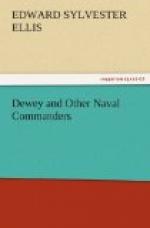Petrel—Fourth-rate cruiser, 890 tons. Speed, 13.7 knots. Guns, four 6-inch, two 3-pounder rapid-fire, one 1-pounder, and four machine guns. Commander E.P. Wood.
Concord—Gunboat, 1,710 tons. Speed, 16.8 knots. Armor, 3/8-inch deck. Guns, main battery, six 6-inch rifles. Commander Asa Walker.
Hugh McCulloch—Revenue cutter, light battery of rapid-fire guns.
Zafiro—Auxiliary cruiser: supply vessel.
The vessels under command of Admiral Montojo were the following:
Reina Cristina—Cruiser (flagship). Built in 1887, iron, 3,090 tons, 14 to 17.5 knots, according to draught, and a main battery of six 6.2-inch rifles.
Castilla—Cruiser, built in 1881, wood, 3,342 tons, 14 knots, and four 5.9-inch Krupps and two 4.7-inch Krupps in her main battery.
Velasco—Small cruiser, built in 1881, iron, 1,139 tons, and three 6-inch Armstrongs in her main battery.
Don Juan de Austria—Small cruiser, completed in 1887, iron, 1,152 tons, 13 to 14 knots, and four 4.7-inch rifles in her main battery.
Don Antonio de Ulloa—Small cruiser, iron, 1,152 tons. Four 4.7-inch Hontoria guns; two 2.7-inch, two quick-firing; two 1.5-inch; five muzzle loaders.
Gunboats Paragua, Callao, Samar, Pampagna, and Arayat, built 1881-6, steel, 137 tons, 10 knots, and each mounting two quick-firing guns.
Gunboats Mariveles and Mindoro, built in 1886 and 1885, iron, 142 tons, 10 knots, each mounting one 2.7-inch rifle and four machine guns.
Gunboat Manileno, built in 1887, wood, 142 tons, 9 knots, and mounting three 3.5-inch rifles.
Gunboats El Cano and General Lezo, built in 1885, iron, 528 tons, 10 to nearly 12 knots, and each mounting three 3.5-inch rifles.
Gunboat Marquis Del Duero, built in 1875, iron, 500 tons, 10 knots, and mounting one 6.2-inch and two 4.7-inch rifles.
* * * * *
Through the bright sunshine and when the stars twinkled in the sky or the full moon rode overhead, the American ships steamed to the southeast across the heaving China Sea. The Stars and Stripes fluttered in the breeze and there was a feeling of expectancy on board the grim engines of war, that had laid aside every possible encumbrance, and like prize-fighters were stripped to the buff and eager for battle.
The run was a smooth one, and as the sun was sinking in the sky Commodore Dewey, peering through his glass, caught the faint outlines of Corregidor Island, and dimly beyond the flickering haze revealed the Spanish fleet in the calm bay. The Commodore had been in that part of the world before, and while waiting at Hong Kong had gathered all the knowledge possible of the defences of Manila. He knew the fort was powerfully fortified and the bay mined, and knowing all this, he remembered the exclamation of his immortal instructor in the science of war, the peerless Farragut, when he was driving his squadron into Mobile Bay. Recalling that occurrence, Commodore Dewey joined in spirit in repeating the words:




